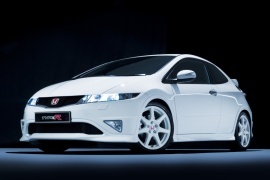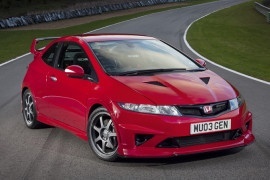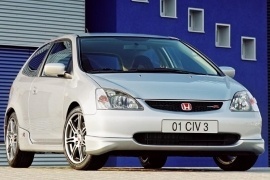
HONDA Civic Type-R
Generations Timeline, Specs and Pictures

When Honda introduced the 2017 Civic Type-R on the market, it ended a 16-year hiatus of rear independent suspension and regained the hot-hatch segment’s crown.
While other carmakers adopted turbocharged engines to boost the power of their powerplants, Honda squeezed more ponies from naturally aspirated ones. But in the end, it had to adopt the turbocharged technology for its hot-hatch. So it installed them on the tenth generation of the Civic and carried over the powerplant from the ninth Civic Type-R.
From the outside, the Type-R looked like a madman tuned it. It featured a massive wing on the back and a dazzling look. Even though not all the grilles on the front and rear bumpers were not functional, they looked mean and added an aggressive look for the Japanese hot-hatch. On the hood, the carmaker added a functional scoop that fed air to the intercooler. Another unique feature of the Type-R was the three pipes in the back. The outer ones were exhausts, while the middle was for an intake and changed the engine sound.
The interior was reworked when compared with the rest of its Civic siblings. It featured wide, sport-bucket Recaro seats upholstered in red suede, which sported the Type-R badges embroidered on their seatbacks. The dashboard looked similar to the other Civics, but it gained a Type-R logo and a new, red background color. Thanks to its unique steering wheel and metallic pedals, the carmaker created a sporty, racy vehicle for petrolheads.
Thanks to the all-wheel independent suspension and adaptive dampers, the Type-R regained its status among the hot-hatches. Moreover, unlike other competitors, Honda installed a six-speed manual only for the vehicle and added a standard limited-slip differential. As a result, the car managed to score record lap-times on various race tracks worldwide, including on the famous Nurburgring.

After five long years of waiting, Honda fans from Europe were pleased with the fourth generation of Civic TypeR.
It is the first generation of the Japanese hot-hatch that received a turbocharger for its 2.0-liter gasoline engine. It is unusual for the master of natural aspirated engines to introduce a turbocharger for the sporty hot-hatch, but it was the only way to keep-up with other European manufacturers such as Ford, Volkswagen or Renault.
From the outside, the lines are dramatically enhanced compared with the regular Civic. A bigger rear wing, bigger wheel-arches and 19” light-alloy wheels are completing the image of a road-warrior compact car. The manufacturer claimed that the exaggerated aerodynamics have been studied so the vehicle will have a negative lift factor, which is unusual for its class.
Inside, the new Recaro front bucket-seats are upholstered in Alcantara and will assure a proper support for the occupants. The rear bench-seat is kind of dull, looking like it will spend its whole life on the garage’s floor. It is flat and without any side support. But it still has Alcantara trim.
The main components of the Civic TypeR are under the hood. The engine offers 310 hp and 400 Nm (295 lb-ft) of torque between 2500 to 4500 rpm. The 6-speed manual gearbox was calibrated for maximum performance so the top speed of 270 kph (168 mph) will be achieved in 6th gear at 6500 rpm. The 0-100 kph (0-62 mph) sprint is obtained in just 5.7 seconds.

Honda refreshed its entire Civic lineup in 2008, presenting the new models at the Paris Motor Show.
The Japanese manufacturer updated their sedan version of the Civic (for the US & Japanese markets), as well as the Type S and 5-door variants for the European market. The Type-R also received some minor changes in terms of exterior design - front fascia and rear section - and was offered with a choice of 3 trim levels: Type-R, Heritage and Heritage Navi. As compared to the 5-door Civic, the Type-R featured a shorter bodywork. This model is assembled at the Swindon plant, in the UK.

This car exudes aggressiveness from the first sight.
Carefully sculpted to achieve improved down force and stability, this mean machine is actually the heart and lungs of the Japanese-spec Civic Type R Mugen in European clothes. With a tuned 2.0-liter i-VTEC petrol engine from Mugen, the car sprints from 0 to 62 mph in 6 seconds period. Developing 240 HP at 8300 rpm and 157 ft-lbs of torque at 6250 rpm, the Civic Type R Mugen is not a car for the faint-hearted. This magnificent machine was meticulously put together and will generously reward the senses only in the hands of skilled drivers.

The eighth generation of the Civic hatchback received a Type R version in 2006, and it wasn’t exactly what the brand’s fan waited.
Honda Civic Type R always was a car designed for enthusiasts, by enthusiasts. Still, the European version of the Type R, the FN2, was available only as a three-door hatchback with the same torsion-beam in the back. While that was useful to increase the trunk space for a family vehicle, it was worse than the independent-type suspension installed on its predecessor, the EP3.
It was a car like no other on the market. Its sharp front end with the narrow grille and slim headlights were features that couldn’t be found elsewhere on the car market. Unlike its regular siblings, the Type R featured a mesh-grille instead of the glass-covered area between the headlights. Its profile was similar to the three-door version, the Type S, but the rear spoiler was specific for the Type R.
The carmaker installed red and black sport bucket seats at the front, with high bolstering to hold the occupants in place during hard cornering. It featured a specific instrument cluster with red background lights instead of the blue ones on the rest of the range. A hidden menu could reveal the shift-lights installed on top of the speedometer, which was in a separate, upper cluster. Yes, the rear seats were folding and could increase the luggage area, but there were just a few who bought a Type R for its trunk space.
Under the hood, Honda installed an 8.000 rpm screaming engine, which provided an extra horsepower (1 hp) than its predecessor. At least it was a Euro 5 compliant engine. As usual, the Type R was available exclusively with a manual gearbox.

The Type R was the sportiest version of the well-known Honda Civic.
Its 8000 rpm screaming engine transformed the 3-door hatchback into an intoxicating hot-hatch.
The seventh generation of the Honda Civic was available in a few body versions, including a coupe, a sedan, a 5-door hatchback, and the 3-door version. The latter was offered as a TypeR as well. It was the first Civic TypeR built in the U.K. and the first to be offered on European soil.
Over time, it gained a lot of nicknames, from the “bread-van” to “screaming box on wheels,” but its look was simple and designed with the “form follow function” concept. A pair of triangular-shaped headlights, with corner-mounted white turn-signals, and a smiling radiator grille didn’t give a clue about what the car could do. The lower grille in the front helped to cool the engine.
Inside, Honda installed red&black sport-bucket Recaro seats with integrated headrests. The rear bench was black with a split-folding seatback to expand the small trunk. Like the 5-door version, the Type R featured an in-dash gear-stick that popped-out through the center stack. Honda installed it there to be closer to the steering wheel and easier to shift gears. The stereo-CD was fitted as standard. Later on, Honda offered a sat-nav system on the options list in selected countries.
The TypeR magic happened under the hood, where the 2.0-liter naturally aspirated engine provided 200 hp. The four-pot featured the VTEC (Variable Valve Timing & Lift Electronic Control) system that allowed the car to go over the magical 100 hp/liter barrier. It was paired to a 6-speed manual and sent the power to the front wheels via a helical LSD. It’s stiffer, fully independent suspension and weight balance made it a fast-cornering car.























































